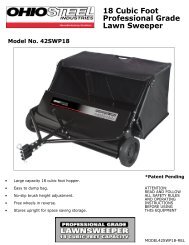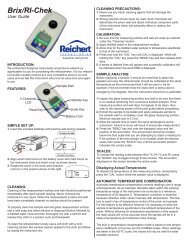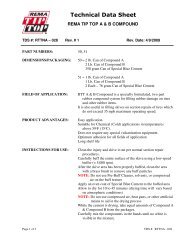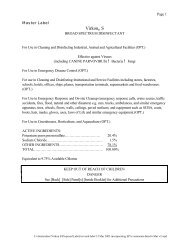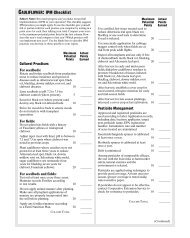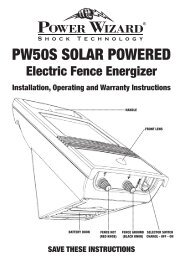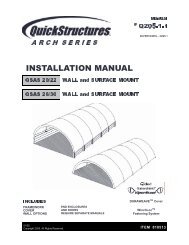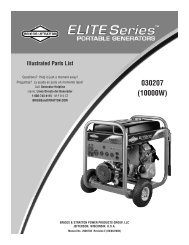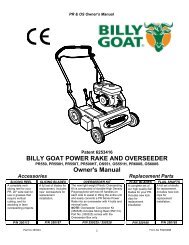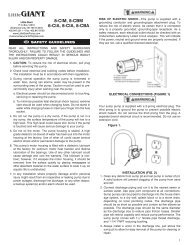Dayton® Generator
Dayton® Generator
Dayton® Generator
You also want an ePaper? Increase the reach of your titles
YUMPU automatically turns print PDFs into web optimized ePapers that Google loves.
Dayton Operating Instructions and Parts Manual<br />
Models 2ZRR1<br />
Install battery-operated carbon<br />
monoxide alarms or plug-in carbon<br />
monoxide alarms with battery backup<br />
in your home, according to the<br />
manufacturer’s installation instructions.<br />
The carbon monoxide alarms should<br />
be certified to the requirements of<br />
the latest safety standards for carbon<br />
monoxide alarms. (UL 2034, IAS 6-96, or<br />
CSA 6.19.01).<br />
Test your carbon monoxide alarm<br />
frequently and replace dead batteries.<br />
Safety warning when refueling<br />
Gasoline is extremely flammable and its<br />
vapors can explode if ignited.<br />
Observe all safety regulations for the<br />
safe handling of fuel. Handle fuel in<br />
safety containers. If the container does<br />
not have a spout, use a funnel.<br />
Do not overfill the fuel tank, leave<br />
room for the fuel to expand.<br />
Do not refill fuel tank while the<br />
engine is running. Before refueling the<br />
generator, turn it off and let it cool<br />
down. Gasoline spilled on hot engine<br />
parts could ignite. Fill the tank only on<br />
an area of bare ground. While fueling<br />
the tank, keep heat, sparks and open<br />
flame away. Carefully clean up any<br />
spilled fuel before starting engine.<br />
Always fill fuel tank in an area with<br />
plenty of ventilation to avoid inhaling<br />
dangerous fumes.<br />
NEVER store fuel for your generator in<br />
the home. Gasoline, propane, kerosene,<br />
and other flammable liquids should<br />
be stored outside of living areas in<br />
properly-labeled, non-glass safety<br />
containers. Do not store them near<br />
a fuel-burning appliance, such as a<br />
natural gas water heater in a garage. If<br />
the fuel is spilled or the container is not<br />
sealed properly, invisible vapors from<br />
the fuel can travel along the ground<br />
and can be ignited by the appliance’s<br />
pilot light or by arcs from electric<br />
switches in the appliance.<br />
Ground fault circuit interrupter<br />
protection. These generators are<br />
equipped with two GFCI (Ground<br />
Fault Circuit Interrupters) 120V duplex<br />
receptacles for protection against<br />
the hazards of electrical shock from<br />
defective attachments such as, tools,<br />
cords, and cables.<br />
A GFCI is a device that interrupts<br />
electricity from either the utility or<br />
generator by means of a special type of<br />
circuit breaker if a fault current flow to<br />
the ground occurs.<br />
A GFCI can be used only with generators<br />
that have the neutral wire internally<br />
bonded to the frame, and the frame<br />
properly grounded to the earth. A GFCI<br />
will not work on generators that do not<br />
have the neutral wire bonded to the<br />
frame, or on generators which have not<br />
been properly grounded. All Dayton<br />
generators have internally bonded<br />
ground wires. A GFCI will not work if<br />
the unit is not properly grounded.<br />
A GFCI may be required by OSHA<br />
regulations, the National Electric Code<br />
and/or local and federal codes when<br />
operating a generator.<br />
For additional protections against shock<br />
hazards due to defective equipment<br />
attached to the twist-lock receptacles,<br />
consider the use of a GFCI on each of<br />
these receptacles as well.<br />
GFCIs and GFCI protected cord sets and<br />
cables may be purchased from local<br />
electrical supply houses.<br />
The GFCIs may not<br />
function unless<br />
the generator is properly grounded.<br />
Follow the correct procedure specified<br />
in the section labeled “GROUNDING<br />
INSTRUCTIONS”<br />
Only the 120V<br />
Duplex Receptacles<br />
are protected by the GFCI.<br />
ELECTRICAL HAZARDS. This product<br />
must be grounded. If it should<br />
malfunction or breakdown, grounding<br />
provides a path of least resistance for<br />
electric current to reduce the risk of<br />
electric shock.<br />
Improper connection<br />
of the equipmentgrounding<br />
conductor can result in a risk<br />
of electrocution. Check with a qualified<br />
electrician or service person if you<br />
are IN doubt as to whether the unit is<br />
properly grounded.<br />
This generator is equipped with a<br />
grounding terminal for your protection.<br />
Always complete the ground path from<br />
the generator to an external ground<br />
source as instructed in the section<br />
labeled “Grounding Instructions” in the<br />
Preparation section of this manual.<br />
The generator is a potential source of<br />
electrical shock if not kept dry. Keep<br />
the generator dry and do not use in<br />
rain or wet conditions. To protect from<br />
moisture, operate it on a dry surface<br />
under an open, canopy-like structure.<br />
Dry your hands if wet before touching<br />
the generator.<br />
Risk of electric shock if you operate<br />
this generator with a faulty GFCI<br />
(Ground Fault Circuit Interrupter). Test<br />
GFCI before each use, see Operations<br />
Instructions for further information.<br />
If GFCI fails test, DO NOT use your<br />
generator. Contact your Dayton<br />
Customer Service Representative.<br />
Plug appliances directly into the<br />
E<br />
N<br />
G<br />
L<br />
I<br />
S<br />
H



